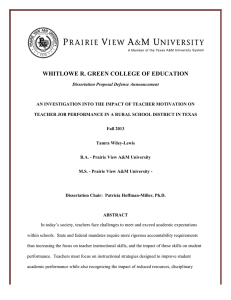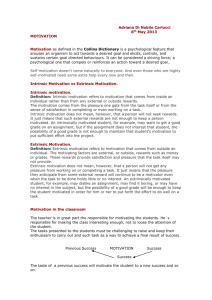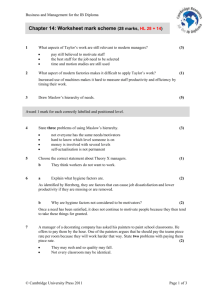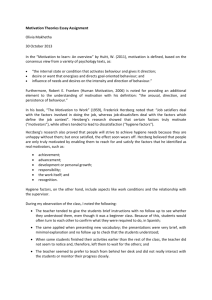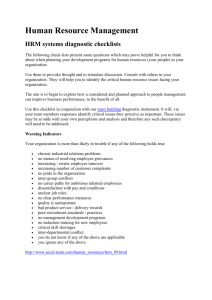JorgeSuañezotaola20..
advertisement
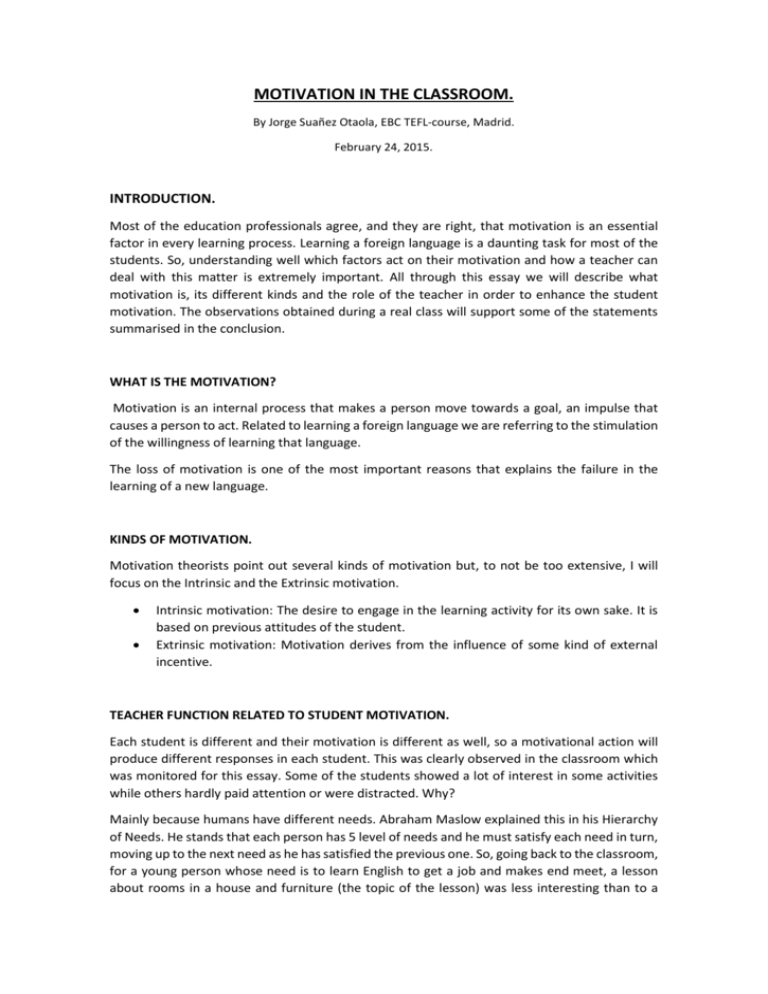
MOTIVATION IN THE CLASSROOM. By Jorge Suañez Otaola, EBC TEFL-course, Madrid. February 24, 2015. INTRODUCTION. Most of the education professionals agree, and they are right, that motivation is an essential factor in every learning process. Learning a foreign language is a daunting task for most of the students. So, understanding well which factors act on their motivation and how a teacher can deal with this matter is extremely important. All through this essay we will describe what motivation is, its different kinds and the role of the teacher in order to enhance the student motivation. The observations obtained during a real class will support some of the statements summarised in the conclusion. WHAT IS THE MOTIVATION? Motivation is an internal process that makes a person move towards a goal, an impulse that causes a person to act. Related to learning a foreign language we are referring to the stimulation of the willingness of learning that language. The loss of motivation is one of the most important reasons that explains the failure in the learning of a new language. KINDS OF MOTIVATION. Motivation theorists point out several kinds of motivation but, to not be too extensive, I will focus on the Intrinsic and the Extrinsic motivation. Intrinsic motivation: The desire to engage in the learning activity for its own sake. It is based on previous attitudes of the student. Extrinsic motivation: Motivation derives from the influence of some kind of external incentive. TEACHER FUNCTION RELATED TO STUDENT MOTIVATION. Each student is different and their motivation is different as well, so a motivational action will produce different responses in each student. This was clearly observed in the classroom which was monitored for this essay. Some of the students showed a lot of interest in some activities while others hardly paid attention or were distracted. Why? Mainly because humans have different needs. Abraham Maslow explained this in his Hierarchy of Needs. He stands that each person has 5 level of needs and he must satisfy each need in turn, moving up to the next need as he has satisfied the previous one. So, going back to the classroom, for a young person whose need is to learn English to get a job and makes end meet, a lesson about rooms in a house and furniture (the topic of the lesson) was less interesting than to a retired middle age woman who wants to satisfy her ancient desire of learning English although she doesn’t need it to live comfortably. It is quite clear that a teacher can do very little in this aspect, then a teacher should focus on what he really can do, and one of the most important thing he can do is to create interest for the activities and the learning process rather than a specific result. What is important is to seek and make motivational activities. Instead of trying to motivate students would be better to create an environment which helps students to motivate themselves. In this sense David Ausubel pointed out that motivation is more a result of the instruction rather than the cause of it. He was a firm believer in the self-discovering methods and the active student participation. During the observed class there were several participative activities and the interest increased notably. Another famous theorist, Frederick Herzberg, emphasized the importance on the class context as a potential dis-satisfier factor. For example, during the observed lesson there were several interruptions for different reasons like a student who arrived late, lack of pens or paper and the student interest dropped off immediately. So then the question is how or what a teacher could do to create situations and an environment which triggers the student motivation. I will briefly mention some of the different techniques that were used in the observed class. The rewards of success. Throughout the class the teacher gave positive feedback during the activities corrections and had a positive impact encouraging the students to continue. Authority. Used in the class when students tend to talk in their mother tongue in the some activities asking them to resume their task. Work in groups. The Observed lesson included various group and pair activities with a positive impact on student motivation. Made the lesson more enjoyable and with better results than if they have worked alone. Presenting activities in order and in a logical way. The lesson followed a coherence and went step by step increasing the vocabulary and the grammar to complete the different activities. Clarity in explanations and activities. In the observed lesson there were some lack of clarity sometimes with an immediate loss of interest, especially in the grammar presentation and the produce activity instructions. Varied activities. The class didn’t have enough variety, most of the activities were worksheets except from the produce activity which was more interactive. That affected the interest in the second half of the class producing moments of boredom in some students. Adequate level of language. Some students during the class lost interest due to the lack of understanding of some instructions expressed with words that they couldn’t understand. Good material and visual tools. The observed class used quite well visuals as pictures and photos which helped the understanding and comprehension of the vocabulary taught. Timing control. The produce activity took much time during the lesson and the interest decreased considerably at the end of that activity. CONCLUSION. As a conclusion to the different statements included in this essay and the observations made in a real classroom, there is no doubt that student motivation plays a very important role in the learning process. The factors which act on each student motivation are various and the teacher couldn’t control or even know most of them, therefore the teacher as a good professional committed to his activity is responsible for the creation of a good environment in the classroom that helps to increase motivation, and to do that there are several techniques and aspects that he must take in consideration. Bibliography. Abraham Maslow. Hierarchy of needs. Available at: http://www.businessballs.com/maslow.htm Frederik Herzberg. Motivational theory, motivators and hygiene factors. Available at: http://www.businessballs.com/herzberg.htm David Ausubel. Subsumption theory. Available at: http://www.instrutionaldesign.org/theories/subsumption-theory.com International TEFL Certificate. Course Manual. Available at: http://www.ebc-tefl-course.com


